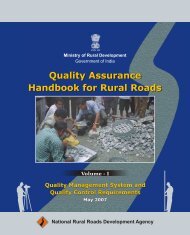environmental assessment and review framework - pmgsy
environmental assessment and review framework - pmgsy
environmental assessment and review framework - pmgsy
You also want an ePaper? Increase the reach of your titles
YUMPU automatically turns print PDFs into web optimized ePapers that Google loves.
ENVIRONMENTAL ASSESSMENT AND REVIEW FRAMEWORK<br />
1. Environmental Selection Criteria for Subprojects<br />
1. Considering the potential direct <strong>and</strong> indirect impacts of the Investment Program,<br />
additional subprojects will be selected by taking into account the following <strong>environmental</strong><br />
criterion: Subprojects will be <strong>environmental</strong>ly sound <strong>and</strong> none will be located within or close to<br />
an <strong>environmental</strong>ly sensitive area such as a wildlife sanctuary, national park, or other areas with<br />
significant ecological functions that are declared as national parks, sanctuaries, or<br />
national/international cultural heritage.<br />
2. Assessment of the <strong>environmental</strong> impacts of the sample roads reveal that <strong>environmental</strong><br />
impacts associated with Investment Program subprojects are similar across the 322 km sample<br />
roads. The <strong>environmental</strong> impacts have the following characteristics: (i) occur only during<br />
construction or are temporary, (ii) reversible, <strong>and</strong> (iii) mitigation measures could be easily<br />
incorporated into design <strong>and</strong> construction. Taking into account the IEE findings for these sample<br />
roads, st<strong>and</strong>ard guidelines for <strong>environmental</strong> management plans—<strong>environmental</strong> codes of<br />
practice—will be prepared to guide the subprojects in incorporating the <strong>environmental</strong><br />
management plan.<br />
3. Taking into account the potential impacts related to the sample subprojects <strong>and</strong> ADB’s<br />
<strong>environmental</strong> <strong>assessment</strong> guidelines, the <strong>environmental</strong> requirement for the follow-on<br />
subprojects is as follow: For each individual subproject, an <strong>environmental</strong> checklist, which will<br />
serve as IEE, will be prepared. However, if the <strong>environmental</strong> checklist indicates that significant<br />
impacts are likely, a st<strong>and</strong>ard full IEE in accordance with ADB’s Environmental Assessment<br />
Guidelines (footnote 1) will be prepared.<br />
4. Since the Investment Program is not subject to the Government’s Environmental Impact<br />
Assessment Notification, the specific procedure to mainstream <strong>environmental</strong> concerns into<br />
Investment Program implementation is formulated in accordance with ADB’s Environmental<br />
Assessment Guidelines (footnote 1).<br />
2. Responsibilities <strong>and</strong> Authorities<br />
5. Project Implementation Unit. The PIU will<br />
(i) complete the detailed project report (DPR) using the <strong>environmental</strong> checklist that<br />
serves as IEE for construction, <strong>and</strong> ensure that construction will be along the<br />
existing alignment; <strong>and</strong><br />
(ii) obtain necessary statutory <strong>environmental</strong> clearance prior to commencement of<br />
civil works.<br />
6. State Rural Roads Development Agencies. The SRRDAs will<br />
(i) ensure that DPRs for follow-on subprojects are completed with the <strong>environmental</strong><br />
checklists that serve as IEE;<br />
(ii) ensure that the <strong>environmental</strong> checklists are <strong>review</strong>ed by the <strong>environmental</strong><br />
officer of the concerned SRRDA; 1<br />
1<br />
If the <strong>environmental</strong> checklist indicates that significant impacts are likely, the SRRDA will report to ADB through<br />
MORD for further guidance.<br />
1
2<br />
(iii) ensure that all required statutory <strong>environmental</strong> clearances are obtained <strong>and</strong> the<br />
conditions noted in the clearances are implemented;<br />
(iv) ensure that the relevant provisions of the <strong>environmental</strong> codes of practice are<br />
followed as part of the effort to mainstream <strong>environmental</strong> concerns;<br />
(v) ensure that bidding documents cover required <strong>environmental</strong> mitigation<br />
measures;<br />
(vi) ensure that the <strong>environmental</strong> checklist, which covers recommendations to<br />
mitigate the impacts, is made available to the contractors; <strong>and</strong><br />
(vii) undertake routine monitoring of the implementation of the identified mitigation<br />
measures.<br />
7. Ministry of Rural Development. MORD will<br />
(i) ensure that the SRRDAs have <strong>environmental</strong> officers;<br />
(ii) ensure that the SRRDAs meet all <strong>environmental</strong> <strong>assessment</strong> requirements;<br />
(iii) undertake r<strong>and</strong>om monitoring of the implementation of <strong>environmental</strong> mitigation<br />
measures;<br />
(iv) <strong>review</strong> the conditions of <strong>environmental</strong> clearance for construction of new roads<br />
with new alignment, as applicable; <strong>and</strong><br />
(v) undertake <strong>environmental</strong> due diligence r<strong>and</strong>omly.<br />
3. Environmental Due Diligence <strong>and</strong> Public Disclosure to Ensure Compliance<br />
with ADB’s Environment Policy<br />
8. MORD, the Executing Agency, should ensure that ADB is given access to undertake<br />
<strong>environmental</strong> due diligence for all subprojects, if needed. However, MORD has the<br />
responsibility for undertaking <strong>environmental</strong> due diligence <strong>and</strong> monitoring of the implementation<br />
of <strong>environmental</strong> mitigation measures for all subprojects. The due diligence as well as<br />
monitoring of the implementation of the <strong>environmental</strong> management plan needs to be<br />
documented systematically.<br />
4. Public Disclosure <strong>and</strong> Public Consultation<br />
9. During the preparation of the DPR <strong>and</strong> filling up the checklist through the transect walk<br />
exercise, the PIU has to ensure that consultation with the affected people <strong>and</strong> their concerns<br />
are recorded. Aside from consultations, all <strong>environmental</strong> <strong>assessment</strong> documents are subject to<br />
public disclosure. These documents should be made available to the public, if requested. In this<br />
context the following system will be adopted:<br />
(i) The SRRDAs are responsible for ensuring that all <strong>environmental</strong> checklist<br />
documentation, including the <strong>environmental</strong> due diligence <strong>and</strong> monitoring<br />
reports, are properly <strong>and</strong> systematically kept as part of the Investment Program<br />
specific records.<br />
(ii) MORD must make the IEE report for the new construction road with new<br />
alignment available on its website.<br />
5. Staffing Requirements <strong>and</strong> Budget<br />
10. Environment specialists of the technical support consultants will check <strong>and</strong> <strong>review</strong> the<br />
<strong>environmental</strong> checklists, <strong>and</strong> to monitor <strong>and</strong> supervise the implementation of <strong>environmental</strong><br />
mitigation measures. The environment specialists will work closely with the state pollution board
to institutionalize the <strong>environmental</strong> codes of practice as the <strong>environmental</strong> guidelines for<br />
development of rural roads.<br />
11. The Investment Program costs have incorporated budget <strong>and</strong> resources needed to (i)<br />
implement the <strong>environmental</strong> <strong>assessment</strong> <strong>and</strong> <strong>review</strong> procedure; (ii) conduct a survey to<br />
complete the <strong>environmental</strong> checklists, <strong>and</strong> conduct IEE for new roads; <strong>and</strong> (iii) monitor the<br />
implementation of the mitigation measures.<br />
3
















